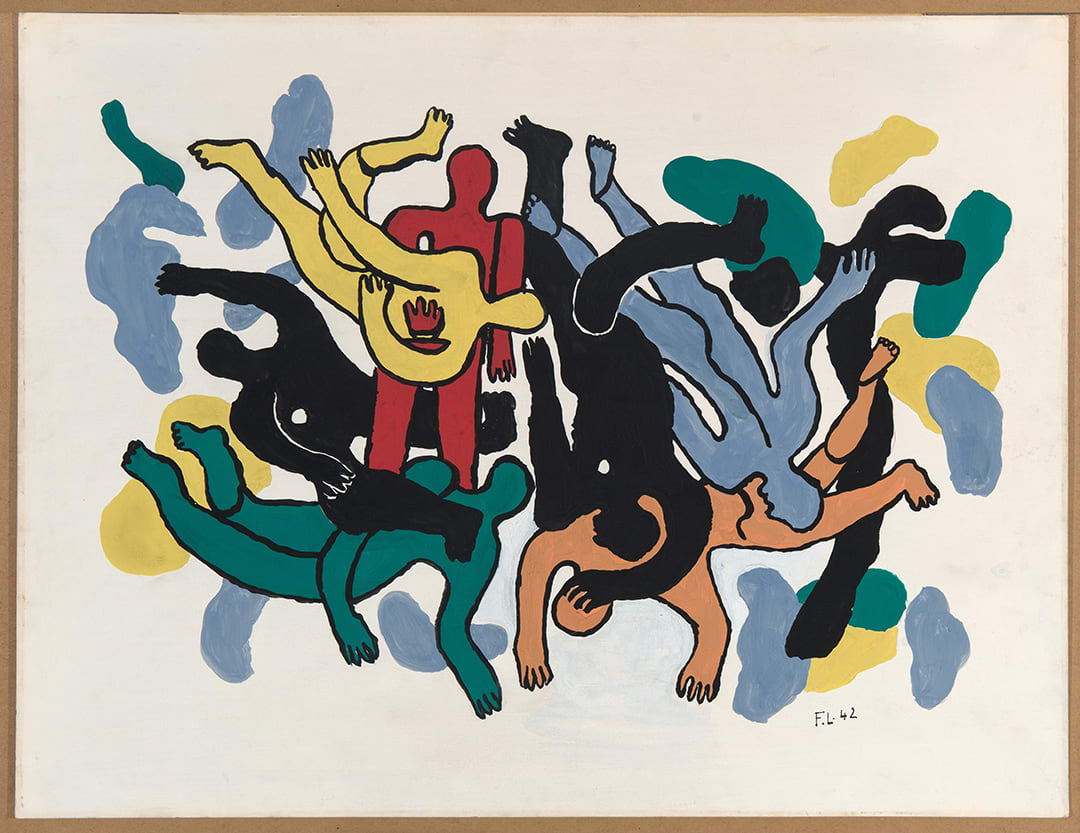Fernand Léger
48.3 x 63.5 cm
Signed and dedicated on verso (upper left) 'à Frankanow amicalement F. Léger'
"...What did I see? Not five or six divers, but at least two hundred of them. I could not make out any longer to whom this head, this leg, or that arm belonged. So, I also scattered the limbs all over in my paintings..." (Fernand Léger, quoted in Sabine Rewald, Twentieth-century Modern Masters, New York, 1989).
In the fall of 1939, Léger was forced to flee Paris and go south to Marseille, where he could catch the boat to his new exile, arriving in the US in November 1940. Léger allegedly came across divers leaping into the Mediterranean Sea while waiting for a boat at Marseilles. The sight of them diving into the water became an inspiration which would carry throughout his work made in exile, including the present work. This fascination would culminate in his later images of divers, including the monumental The Great Divers Black (1944) in the Centre Pompidou, which bears a striking compositional similarly to the present work and was made two years earlier.
When Léger first arrived in America, he stayed at the University Club in New York City where he had little room to paint, forcing him to work on smaller scale and often on paper. Following a teaching stint at Mills College in California, Léger returned to New York by 1942 where he was reportedly inspired by the advertising spotlights on Broadway that would suddenly illuminate pedestrians in a rainbow of colors: standing on the street, a man would turn blue then red or yellow. He would later remark, "America has added color to my palette" (Léger, quoted in Art: Machine Age, Paris Style, Time Magazine, 1946.)
In 1942, the year of the present work, Léger refined his approach to depicting the divers: no longer but an entangled jumble of arms and legs, his figures were delineated by thick black outlines and a flat, stylistic application of color that would come to be a hallmark of his most celebrated work. His museum collections include the Museum of Modern Art, the Guggenheim, the Metropolitan Museum of Art, and the Musée national Fernand Léger in Biot, France.
Provenance
This artwork was acquired sometime before 1962 by Myrtil Frank, a well-known art dealer active in the city of Den Haag in the Netherlands and in Manhattan, New York. It remained in the Myrtil and Flory Frank collection until both passed away.
• 1982, by descent to Dorrit Hilda Frank, daughter of Flory and Myrtil Frank, New York
• 2014, by descent to Lisa Lempel-Sander and Elliot Sander, New York Exhibition History
Exhibitions
This artwork was exhibited at The Solomon R. Guggenheim Museum, New York in an exhibition titled Fernand Leger, Five Themes and Variations in 1962. On page 20 of the catalogue is the following annotation: STUDY FOR THE DIVERS, (ETUDE POUR LES PLONGEURS). 1942. Gouache, 19 x 25”, Collection Mr. and Mrs. Myrtil Frank, New York. On page 23 of the catalogue is a photograph of the artworkLiterature
Solomon R. Guggenheim Museum, New York, ‘Fernand Leger, Five Themes and Variations’, 1962, page 20, illustrated page 23
